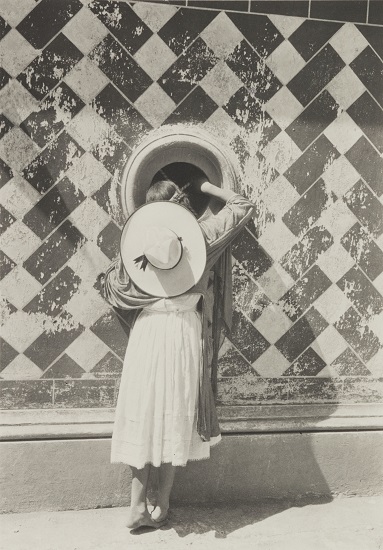
Manuel Álvarez Bravo
Mexican, 1902-2002
The Daughter of the Dancers, 1933, printed 1981
platinum print, ed. 11/25
12 × 10 in.
SBMA, Gift of Joan Almond
2017.21.1.4

Undated Self-Portrait
“I think that a visual artist’s philosophy develops much more freely than a writer’s or a thinker’s philosophy. It is not so disciplined. The photographer works with both his eyes and his mind." - Manuel Álvarez Bravo
COMMENTS
The photograph “La Ija de los Danzantes” (“The Daughter of the Dancers”), 1933, represents a young girl in Mexican attire, with her back to the viewer, peeking through a dark window on an old façade, decorated with geometrical patterns and battered by the sun and wind. Beyond the grace of her pose, the composition of the image and its local color and exoticism, the photograph contains deeper meaning reaching into the distant past of Mexico. “Danzantes”, in addition to its literal meaning of “dancers”, is the name given to a certain type of wall carvings and reliefs in the ancient architecture of Mexico. The young girl’s odd position on her toes, one foot over the other, and the positioning of her arms are reminiscent of a dancing figure. The wall against which she is leaning, with its peeling paint, reminds us of an ancient temple. It is only one step from this young girl of the twentieth century to pre-Cortesian civilizations. Even her right hand, disappearing through the window in the darkness of the building, gives us the impression of her trying to reach down to her roots in the darkness of ancient history. We may well identify the young girl with today’s Mexico, still bound to its history and heritage.
- Dreams – Visions – Metaphors: The Photographs of Manuel Alvarez Bravo, Andre Deutsch, London, 1983, pp. 14-15
In this picture, as in many of Álvarez Bravo's photographs, our experience begins with the theme of looking: we must wonder what it is that the girl sees, or what she seeks. It has been suggested that her awkwardly placed feet, with one foot atop the other as she stands on her toes, evokes the figures in Mexican reliefs and carvings made before the Spanish conquest, and that the girl, dressed in traditional Mexican costume, may be interpreted as representing a Mexico searching for its past through the window in the well-worn wall. Clearly, the picture was staged, and we know that the photographer has intentionally provoked our curiosity.
Photography has an inherent power to create mystery because it only describes aspects of things and never tells the whole story. In the hands of a skillful photographer, this capacity to intrigue can become the foundation of an aesthetic, a way of working. Throughout his seventy-five-year career, the Mexican photographer Álvarez Bravo consistently made deeply human photographs rife with enigma.
- Publication excerpt from The Museum of Modern Art, MoMA Highlights, New York: The Museum of Modern Art, 1999, rev. 2004, p. 176.
https://www.moma.org/collection/works/52772
